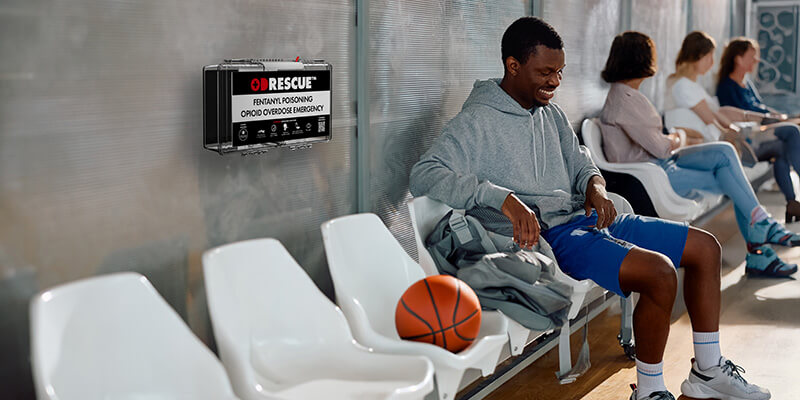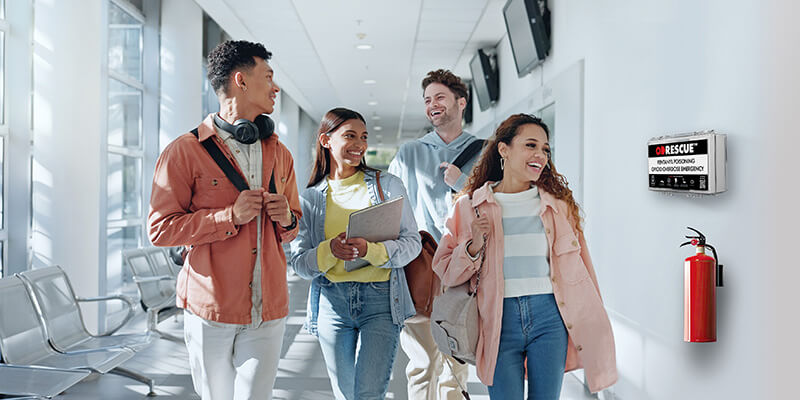Enhancing Safety in Education with ODRescue™
These sobering statistics underscore the need for naloxone-equipped ODRescue™ Boxes to be everywhere students are located, from middle and high schools to colleges and universities:
- A survey conducted by Penn State researchers found that approximately 1 in 5 college students knew someone addicted to pain medications. A third of survey participants said they knew of someone who overdosed on painkillers or heroin.
- From 2019 to 2021, overdose deaths increased among young adults ages 14 to 18, according to the Centers for Disease Control and Prevention (CDC). Average monthly overdose deaths of adolescents ages 10 to 19 increased 109 percent from July-December 2019 to July-December 2021. Deaths involving illicitly manufactured fentanyl (IMFs) increased 182 percent. About 90 percent of deaths involved opioids and 84 percent involved IMFs. Also, two thirds of fatalities had one or more potential bystanders present, but most did nothing to help.
Potential irreparable brain damage can occur 4 minutes after opioid-induced (e.g., fentanyl, heroin) respiratory distress.1
In 2022 alone, “the equivalent of a high-school classroom’s worth of students” died every week from drug overdose, according to a New England Journal of Medicine article titled “The Overdose Crisis among U.S. Adolescents.”
Get More Information
Learn more about how ODRescue™ can equip your school with life-saving tools to help someone’s loved one when they need it most.
According to a Boston University School of Public Health study exploring college-aged opioid overdose knowledge published in the JAMA Pediatrics journal last year:
- Fewer than 15% of U.S. college students surveyed knew how to administer naloxone in an overdose situation.
- Only 30% understood what naloxone is used for.
- Nearly 62% said they could identify one symptom of opioid overdose.
- Nearly 67% felt comfortable calling emergency personnel if they witnessed an overdose.
Statistics Underscore the Need for Naloxone-Equipped ODRescue™ Boxes to be Everywhere Students are Located

Changing Statistics, Changing Lives
Guests from all walks of life patronize your establishment on any given day. Without knowing everyone’s circumstances, it is safer to be prepared for any situation with an ODRescue™ Box or Pouch. Access to naloxone within the first few minutes can mean the difference between life or death.
Where to Place ODRescue™ Boxes:
- Libraries
- Common spaces
- Football fields and other sports facilities
- School hallways near AEDs and other safety equipment
- Dormitories, residence halls and Greek letter organizations
- Campus safety departments
- Health services offices
Make an ODRescue™ Box available for staff and students when naloxone is needed immediately to help bend the curve of fentanyl and opioid overdose.

Make an ODRescue™ Box Easily Available for Staff and Students When Naloxone is Needed
Why ODRescue™
Each ODRescue™ Box accommodates four doses of naloxone and is equipped with an adult/child CPR mask, a one-way valve with filter, nitrile gloves, antiseptic wipes, along with common overdose signs right on the front of the box. A QR code leads to further resources to help educate your student body about overdose emergencies and the steps that can be taken to save a life.
We also will restock the naloxone (with a 2-year shelf life) in an ODRescue™ Box as we monitor the expiration date for you, leaving your campus professionals and educators with more time to plan for the success of your students.
Let's Discuss This Further!
As you consider the wellness initiatives for your staff and students, consider how having naloxone within arm’s reach throughout your campus could fit into your philosophy.
If you’re a dean of students, health administrator, campus safety manager or principal, we want to answer your questions and help illustrate how ODRescue™ products provide an additional safety layer and minimize worst-case scenarios for someone’s loved one.